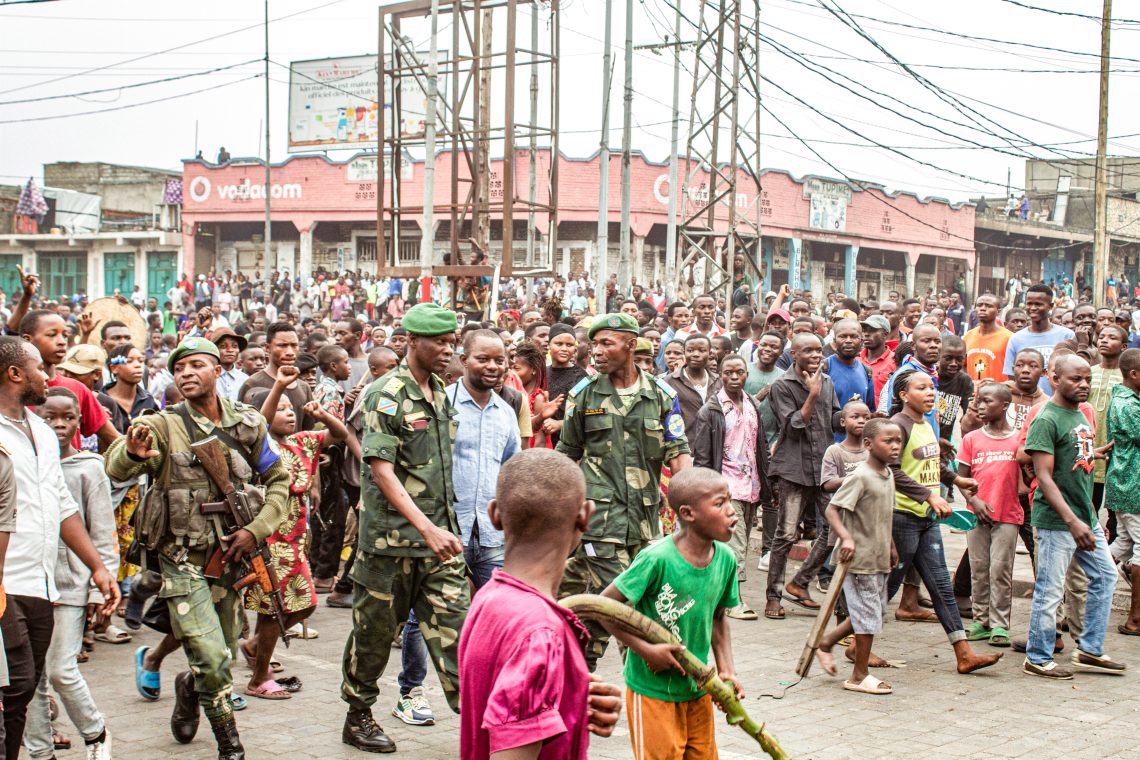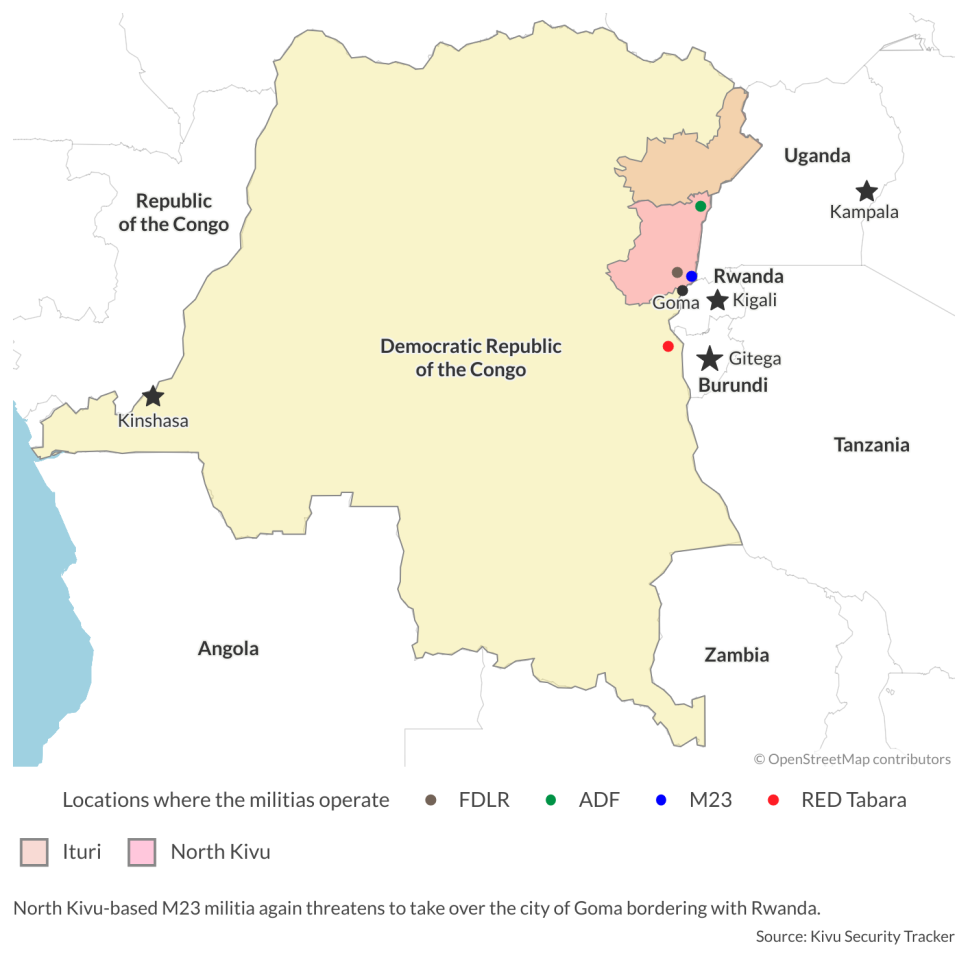Is the Third Congo War approaching?
The plethora of proxy and internecine wars in the rebel-overrun eastern parts of the Democratic Republic of the Congo is slipping out of anyone’s control.

In a nutshell
- Rebel-caused instability in eastern DRC has reached dangerous levels
- All regional and international attempts to negotiate a cease-fire fail
- The DRC-Rwanda rivalry pushes both to the brink of an open war
Over the past quarter of a century, the resource-rich eastern provinces of the Democratic Republic of the Congo (DRC) have served as operating bases for multiple rebel groups. As a result, the region is an ungovernable arena of contest among its direct neighbors.
The latest iteration of the trouble started in November 2021, when the military group known as the March 23 Movement (M23) attacked the Congolese army in North Kivu. The M23 offensive reignited the crisis, whose root causes were never addressed.
They go back to 1994 when the genocide in Rwanda triggered an exodus of two million refugees into neighboring countries, most of them to Zaire (now the DRC). Rwanda and Uganda helped oust Zaire’s President Mobutu Sese Seko (1965-1997) by supporting Laurent Kabila during the First Congo War (1996-1997).
A destabilization followed, and armed groups proliferated and became agents of proxy wars in the region.
Facts & figures
The FDLR and M23
- The Democratic Forces for the Liberation of Rwanda (FDLR): Founded in Congo in 2000 by former members of the Rwandan genocidal regime, it aims to defeat the present Rwandan government. Kigali treats the movement as an existential threat.
- The M23 rebel group: Created in 2012 by Congolese Tutsis with the support of Rwanda and Uganda, it officially aims to protect the Tutsi populations in Eastern Congo. It is named after the deal signed on March 23, 2009, between an armed militia (National Congress for the Defense of the People, CNDP) operating in North Kivu and the Congolese government. In 2012, a CNDP faction accused the government of violating the deal and took control of the border city of Goma in a quick offensive. M23 was defeated in 2013 in what was perceived as a diplomatic and military success.
- Taken together, by estimates as many as 120 rebel groups have operated in the DRC’s easternmost provinces.
In March 2022, the fight between the M23 and the DRC army resumed, despite a cease-fire brokered by Angola. While some of the main parties in the conflict would benefit from stabilization, a negotiated solution seems increasingly unlikely: multiple actors with conflicting agendas are involved, and ethnic violence is on the rise again. On top of these, the upcoming presidential election in the DRC adds a volatile element.
Why stabilization attempts are failing
Despite the regional mediation efforts, there are some worrying signs of escalation. Rwanda’s President Paul Kagame accused the Congolese government of bringing cheap but deadly effective Soviet-era multiple missile launchers (the BM-21s) to the region and using them to shell Rwandan territory. In January 2023, a Congolese fighter jet allegedly violated Rwanda’s airspace.
Like in 2011, the M23 is advancing toward the city of Goma in the Nord Kivu province bordering Rwanda and Uganda. But while 12 years ago, the group was eventually stopped and a negotiated agreement was reached, the M23 offensive may end up differently this time.
In a region scarred by ethnic violence and political fragmentation, reports of atrocities committed by both sides against civilians, including summary killings and systematic rape, are fueling resentment and fears. Hate speech has become more common over the last months.
Facts & figures
Members of Tutsi communities claim there has been a campaign of intimidation to prevent them from registering to vote in the upcoming December presidential elections. That fuels the perception that Tutsis are treated as second-class citizens in the region and exposed to cyclical outbursts of violence, which provides the M23 actions with a powerful justification. The horrors perpetrated by the M23 rebels against civilians, in turn, fuel anti-Tutsi rage, thus creating a vicious cycle of violence.
After years of systematic failure, regional and international mediators have apparently exhausted their credibility. The regional initiatives aimed at replacing the increasingly unpopular United Nations’ “stabilization mission” in the DRC (MONUSCO) have initially been welcomed as an implementation of the “African solutions for African problems” principle, but that also has proven difficult on the ground. Two parallel processes are going on, each under the leadership of a regional power – Kenya and Angola – which adds more complexity to the already knotty situation. Military deployments accompany diplomatic efforts. Kenyan and Burundian troops have been deployed under the East African Community Regional Force, while Angola will also send military units. Similar dynamics preceded the Second Congo War (1998-2002).
Read more on Congo’s struggles
The true strengths of sub-Saharan Africa
Finally, the conflict may be described as a proxy war between two long-standing regional rivals. It shows that Kinshasa and Kigali may be losing their capacity to influence the M23, the FDLR and scores of other rebel groups operating in the region. For example, the Allied Democratic Forces (ADF), which pledged allegiance to the Islamic State and was responsible for terrorist attacks in Uganda, has increased its operational reach and is now considered the most violent group in the region.
As violence escalates and elections in the DRC draw nearer, direct dialogue between the Congolese government and the M23 – as envisioned in the Kenyan mediation plan – has become implausible.
Facts & figures
The four actors
- By area, Rwanda is one of the smallest countries in sub-Saharan Africa, and the DRC is the largest. The DRC’s population is at present above 100 million, while Rwanda’s slightly exceeds 13 million. The Congolese armed forces are several times bigger than the Rwanda Defense Force. However, Rwanda is a much more functional state and has significant international sway.
- Rwanda, Uganda and Burundi consider Eastern Congo an extension of their own territories. Through rebel groups or state-sponsored military presence, these countries have been trying to increase their regional leverage and pursue political goals. The Rwandan regime believes it is responsible for the protection of all Tutsis, including those living in the DRC and other countries.
- Uganda has a security motivation for its presence in the DRC. The Islamist rebel group ADF, which most recently carried out bomb attacks in Kampala in November 2021, has operational bases in North Kivu and Ituri. Ugandan President Yoweri Museveni, who is in an increasingly weak position, has negotiated the deployment of Ugandan forces in Congolese territory, which triggered anxiety in Rwanda.
- Burundi is another neighbor with security interests in the DRC. President Felix Tshisekedi has recently allowed Burundian forces into Congolese territory to neutralize RED-Tabara, the most active rebel group opposed to the Burundian government and responsible for attacks in Burundi.
Global tensions thwart diplomatic efforts
On the external front, diplomatic tensions are increasing and impacting the dynamics of regional cooperation. Since coming to power in 2019, DRC President Tshisekedi has worked to increase the weight of the DRC in regional and subregional organizations, thus opening another area of competition with Rwanda. His efforts have brought some results: President Kagame recently accused the DRC of excluding Rwanda from the Economic Community of Central African States summit, which took place in the Congolese capital.
The principal external players, including the United States and the European Union, have stopped short of openly condemning Rwanda. However, there is a consensus that M23 is indirectly backed by Kigali, which supplies the rebels with weapons, ammunition and logistical help. At the same time, Rwandan intelligence services claim that the Congolese army closely cooperates with the FDLR, a force that includes some of those responsible for the genocide against the Tutsis. The group, which has operated in Congolese territory since 1996, was never disarmed and, according to Rwanda, is used by Kinshasa as a proxy agent to stir unrest in the volatile region.
Significantly, Beijing abstained from putting forward diplomatic initiatives with its diplomats but has increased its military assistance to the DRC over the last years.
While the international community is focused on the war in Ukraine, recent events in eastern Congo have set alarm bells beyond the region. After the attempts to implement a cease-fire failed, a UN Security Council delegation went to the DRC. The EU started a humanitarian operation to fly in aid to Goma.
Upping the ante: Geoeconomics
The conflict in North Kivu has geoeconomic aspects as well. The DRC happens to be extremely rich in cobalt, the lustrous metal considered critical to energy transition and the fourth industrial revolution. The DRC produces more than 70 percent of the world’s supply, while China is the world’s top cobalt consumer, accounting for 80 percent of the DRC output. However, relations between Beijing and Kinshasa are not always easy, as President Tshisekedi has privileged diplomatic ties with Washington.
China’s presence in the country’s mining sector has increased, and more than half of cobalt exploitation operations are owned or coowned by Chinese companies. The Congolese economy benefits richly from the rising demand for minerals like cobalt or copper.
Read more Africa’s violence roots
The African Union’s 20 years: Record and new challenges
These facts suggest that Kinshasa and Beijing have a shared interest in stabilization. Russia, which has been expanding its presence in Africa, could also gain from a closer relationship with the DRC, where anti-western sentiment is rising like in some Sahelian countries. Moscow could exploit the situation by expanding Russian firms’ presence in the mining sector, reinforcing its position as a provider of military equipment, or even – although less likely – by deploying its Wagner Group mercenaries.
In the DRC, in Mali or the Central African Republic, the Western countries’ efforts have failed to bring in stabilization, regardless of whether the Europeans and Americans acted through the UN or assisted regional approaches. While the DRC has voted against Russia in several United Nations General Assembly resolutions, and President Tshisekedi seems bent on reassuring Washington and Brussels, the policy does not seem to have much support at the governmental and popular levels. The upcoming elections may unleash some strategic changes.
Scenarios
At this point, considering the recent failure of another regional mediation, the increasing levels of ethnic violence and the December presidential elections in the DRC, two scenarios emerge.
Another regional war erupts
Under the first script, we see increasing hostility and tit-for-tat provocations leading to a full-bore military conflict accompanied by abhorrent violence against civilians. That would destabilize the broader African region right at a time when refugee flows are gaining in strength.
Two factors make this the most probable scenario. One is the increasing number of regional actors operating, from regional forces to multiple armed groups with unclear chains of command. The other aspect, the upcoming elections in the DRC, adds to an environment that is not conducive to effective negotiations. For example, the integration of the M23 forces into the Congolese army – one of the demands of the rebel group – could damage the reputation of President Tshisekedi and carry electoral consequences.
Cold reason unexpectedly prevails
The second scenario has much less likelihood. It sees violence contained by Kigali and Kinshasa and the conflict’s de-escalation through diplomatic means informed by balanced security needs and economic interests. President Tshisekedi finds stabilization the best solution as he prepares his reelection bid. At the same time, President Kagame accepts that economic cooperation with the DRC and other neighbors would benefit the Rwandan economy. He knows the opposite scenario of aid suspension or Western sanctions could upset its successful development trajectory. However, this desirable scenario is unlikely because the DRC and Rwanda are no longer in control of the armed groups operating in the region.










